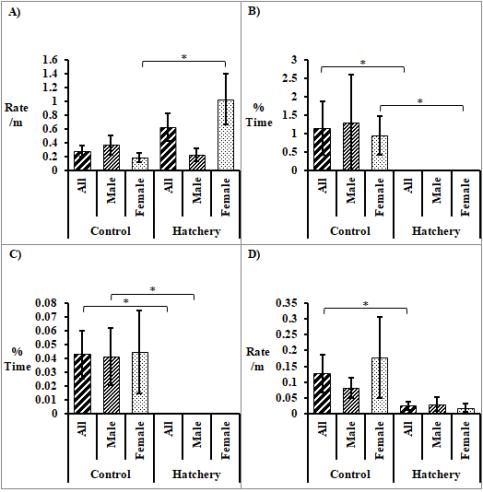Novel arena
Conducted at 2 days old

When looking at the percentage time performing behaviours the hatchery chickens spent a significantly lower percentage time performing the following behaviours; total exploration (Figure 7: C), walking, standing relaxed (Figure 7: D), preening, dustbathing, exploring ground, exploring objects (p<0.05, for complete list of p values see: Appendix: Table 4). The hatchery group spent a significantly higher percentage time in start box (p<0.05) (Figure 7: A) and a tendency towards a higher percentage time escaping (p<0.1). Lower rate per minute; transverses (Figure 7: B), conspecific pecks (Figure 7: F), total explorative pecks, comfort behaviours (Figure 7: E), feather ruffle, ground pecks, object pecks (p<0.05).
When comparing hatchery males to control males it was found that hatchery males spent a lower percentage time performing; total exploration, standing relaxed, exploring ground, exploring object, preening (p<0.05). Hatchery males also spent a higher percentage time in start box (p<0.05). Hatchery males also had a lower rate per minute for the following behaviours when compared to the control males; total explorative pecks, comfort behaviours, ground pecks, object pecks (p<0.05). There was also a tendency towards hatchery males performing transverses and scratch body at lower rate per minute when compared to control males (p<0.1).
When comparing hatchery females to control females, hatchery females spent a significantly lower percentage time walking, standing relaxed, and exploring the ground (p<0.05). Hatchery females also had a tendency towards spending a higher percentage time in the start box and standing alert (p<0.1). Hatchery females also had showed tendency towards a lower percentage time spent sleeping (p<0.1). When compared to control females, hatchery females performed the following behaviours at a significantly lower rate per minute; feather ruffles, ground pecks, object pecks (p<0.05). Hatchery females also showed a tendency towards performing transverses and total explorative pecks at a lower rate per than control females (p<0.1).
Conducted at 6 weeks old

The results of the novel arena testing conducted at 6 weeks of age showed that hatchery chickens spent a significantly lower percentage time running (Figure 8: C) and drinking (Figure 8: B) when compared to control chickens (p<0.05, for full list of p values see Appendix: Table 5). Hatchery chickens also showed a significantly lower rate of feather ruffles and conspecific pecks (Figure 8: D) per minute than control chickens (p<0.05), however hatchery chickens showed a tendency to perform a higher rate of wing stretches per minute than control chickens (p<0.1).
When comparing the results for hatchery males versus control males, hatchery males performed a significant lower percentage time running that control males (p<0.05). Hatchery males also showed a tendency to perform a lower rate of feather ruffles per minute than control males (p<0.1).
Hatchery females performed drinking behaviours for a significantly lower percentage time than control females (p<0.05). Hatchery females, however, showed a tendency to spend a higher percentage time sitting relaxed than control females (p<0.1). When looking at feather ruffle behaviours, hatchery females showed a tendency to perform this behaviour at a lower rate than control females (p<0.1). Hatchery females also performed leg stretching, wing stretching and all comfort behaviours (Figure 8: A) at a significantly higher rate per minute than control females.
Responsible for this page:
Director of undergraduate studies Biology
Last updated:
05/22/18
